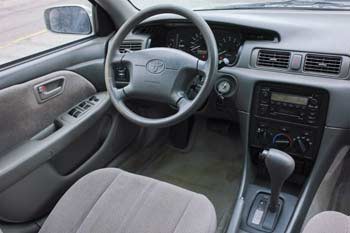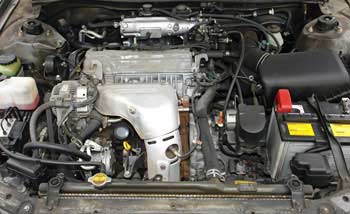Toyota Camry 1997-2001 problems, fuel economy, driving experience, photos
Updated: December 15, 2021
The late 90's, early 2000s were the best years for the Toyota Motor company. Many experts agree that the 1997-2001 Camry known as XV20 is one of the most reliable cars ever built. Even today you still can see quite a few of them on the road.
The Camry offers a comfortable interior and a soft, quiet ride. It comes as a four-door sedan or two-door coupe (Camry Solara). The interior is roomy, with soft seats and easy-to-use controls. There is plenty of head- and legroom for front and rear passengers. The trunk is large and the rear seat backs fold down for more cargo space.
The Camry has front-wheel drive and comes with a 4-cylinder or V6 engine and a 5-speed manual or 4-speed automatic transmission. Maintenance and repair costs are low. The 4-cylinder Camry is rated among the best in its class for fuel economy. It's a reliable car and with good care can easily last for over 300K miles. What are the common problems?
Toyota Camry reported problems: A bad vacuum switching valve (VSV) for the EGR located under the intake manifold could cause the trouble code P0401 in a 4-cylinder engine. Watch these videos. The EGR valve itself and other things need to be checked, but often, a new VSV valve fixes the problem.
A failed catalytic converter can cause the code P0420; the OEM catalytic converter is expensive, but it's possible to find an aftermarket part that is much cheaper.
A faulty starter solenoid can cause a no-start condition where the starter would click but would not crank. The starter motor will need to be rebuilt or replaced.
 Toyota Camry 2001 Interior. Click for a larger photo
Toyota Camry 2001 Interior. Click for a larger photo
Broken wires in the trunk lid wiring harness near the driver's side hinge could cause various electrical problems, including various warning lights, taillights and reverse light issues. Wires typically break where the harness flexes from opening and closing the trunk lid.
A dirty idle air control (IAC) valve in the throttle body can cause stalling and rough idle. Cleaning the IAC valve can help if there are no other issues.
Oil leaks from the valve cover gasket are common. The gasket set is not expensive and is easy to replace in the 4-cylinder engine (0.8 hours), but requires more work in the V6 (3.9 hours). If spark plugs are old it's a good idea to replace them at the same time, as they are in the same area.
A bad oxygen sensor (Bank 1 Sensor 1) can cause the code P0135. The sensor will need to be replaced. In the 1MZ-FE engine, Bank 1 is the rear cylinder bank.
The trouble code P0446 could be caused by a bad EVAP vacuum switching valve (VSV). The repair often involves replacing the EVAP vacuum switching valve (VSV) and the charcoal canister as an assembly, but if you want to save money, try replacing just the EVAP VSV and cleaning all the vacuum hoses at the canister; sometimes it may be enough to fix the problem.
Bad strut mounts could cause a knocking or rattling noise in the front suspension. Bad stabilizer bar bushings/links can also cause similar noises. If you hear a knocking noise coming from the front suspension, have it checked out, as the car might be unsafe to drive.
If the cabin heater fan works only at the high speed position, the blower motor resistor is the first part to check. Usually either the connector or the resistor itself gets corroded, causing this problem. The blower motor resistor is not a very expensive part and is fairly easy to replace.
Engines: The base 136-hp 2.2-liter 4-cylinder DOHC 5S-FE engine is simple and easy to maintain.
 Toyota Camry 2.2-liter 5S-FE engine.
Toyota Camry 2.2-liter 5S-FE engine.
The 194-hp 3.0-liter 1MZ-FE V6 is smooth and offers plenty of power. Both are very good reliable engines; with regular maintenance you shouldn't have too many problems with either one.
Timing belt or chain: Both, the 5S-FE and 1MZ-FE engines have a timing belt (for 2000 and 2001 Camry, Toyota recommends replacing the timing belt every 90,000 miles). Replacing a timing belt will cost from $320 to $570 (it's more expensive in a V6).
Fuel Economy: The EPA rates the 1998-2000 Camry with a 4-cylinder engine and an automatic transmission at 20/28 mpg or 11.8/8.4 L/100 km city/highway, which means you can travel approximately 382 miles (614 km) on one 18.5-gallon (70 liter) tank with a mix of 55 percent city and 45 percent highway use. The 1998-2001 Camry V6 auto gets 17 mpg city, 25 mpg highway (13.8/9.4 L/100 km).
Handling and ride: The Camry has a soft and quiet ride. The steering is light, without much feedback. Soft suspension absorbs road bumps and expansion joints well, but some body roll is noticeable when cornering. Overall, handling is secure and comfortable, although not sporty.
Safety: Antilock brakes are standard in all but base models. In the NHTSA frontal crash tests, the 1997 Toyota Camry received four stars for both the driver and the front passenger; the improved 1998-2001 Camry received four stars for the driver and five stars for the front passenger.
Pros: Reliability, fuel economy (4-cylinder models), soft and quiet ride, comfortable interior, easy to maintain, easy to sell.
Cons: Plain interior styling, body roll in turns, steering wheel wears fast, both engines have a timing belt that must be replaced at recommended intervals.
Related reviews:
Mazda 6 2003-2008 review
Honda Accord 2003-2007 review
Toyota Camry 2007-2011
Honda Accord 2008-2012 review
Toyota Corolla 1998-2008 review
Toyota Camry 1997-2001 review
Nissan Altima 2007-2012 review
Toyota Corolla 2009-2013 review
Toyota Camry 2002-2006 review
What to look for when buying a used Toyota Camry: When buying an older car, especially the one that has been driven in the region where road salt is used in winter months, it's important to check the underneath of the vehicle. Parts like brake and fuel lines, crossmembers and the fuel tank need to be carefully inspected for rust and leaks. Avoid the vehicle if the rust damage is excessive. When test driving the car, if you notice blue smoke from the exhaust, even if it's just a small cloud at a start up, avoid the car. Watch out for oil leaks. A knocking noise from the front suspension when driving on rough roads may indicate bad suspension components (bad front strut mounts were common). Check for signs of sludge under the oil filler cap with the engine off. If the "Check Engine" light is on, have it checked before buying a car; some problems are expensive to repair. Read more tips: How to inspect a used car - illustrated guide. Before buying, have the car inspected. Read also:
What mileage is OK for a used car?
Signs of engine problems when test-driving a used car
Maintenance tips: To keep your engine in good shape, we recommend doing oil changes every 3,000-3,750 miles. Overheating may cause serious problems; to avoid overheating, keep the engine coolant topped up and timely repair coolant leaks. Change automatic transmission fluid whenever it becomes dirty. The PCV valve also needs to be regularly inspected and cleaned or replaced if needed. A clogged PCV valve can cause increased sludge build-up inside the engine. For repairs, use original Toyota parts; they are not too expensive. If the brake pedal feels too low, the brakes need to be serviced. Have your car inspected, at least once a year, in a garage on the lift to keep it safe.
Engine oil capacity (drain and refill):
4-cylinder 5S-FE Engine (With filter): 3.8 US qt (3.6L)
V6 1MZ-FE Engine (With filter): 5.0 US qt (4.7L)
Source: https://www.samarins.com/reviews/camry_97.html
Posted by: linhlinhpeifere0271903.blogspot.com
Post a Comment